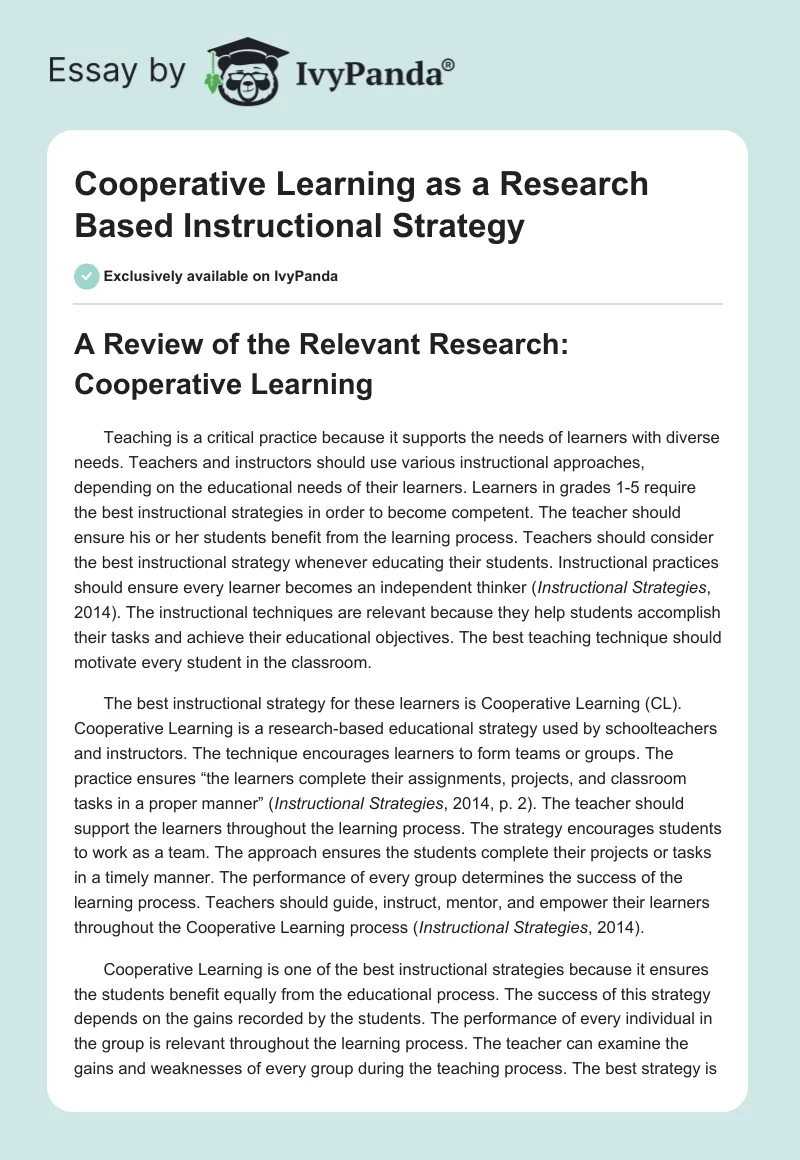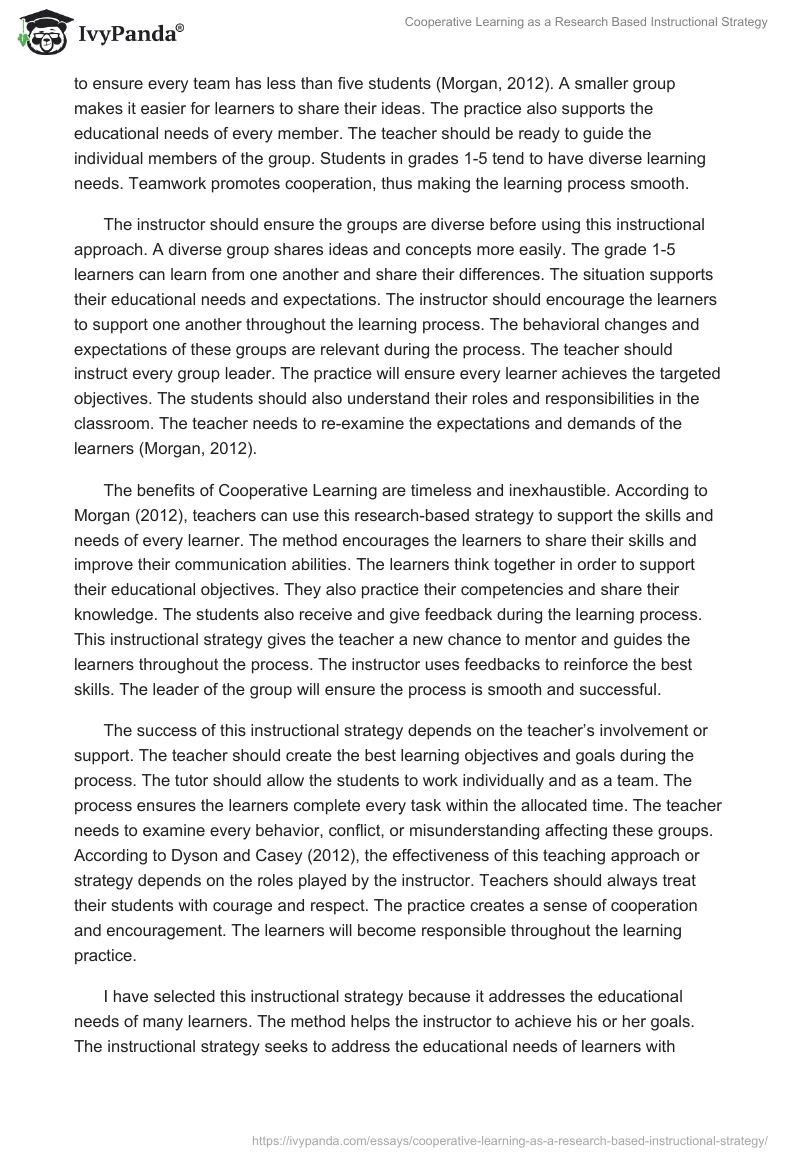A Review of the Relevant Research: Cooperative Learning
Teaching is a critical practice because it supports the needs of learners with diverse needs. Teachers and instructors should use various instructional approaches, depending on the educational needs of their learners. Learners in grades 1-5 require the best instructional strategies in order to become competent. The teacher should ensure his or her students benefit from the learning process.
Teachers should consider the best instructional strategy whenever educating their students. Instructional practices should ensure every learner becomes an independent thinker (Instructional Strategies, 2014). The instructional techniques are relevant because they help students accomplish their tasks and achieve their educational objectives. The best teaching technique should motivate every student in the classroom.
The best instructional strategy for these learners is Cooperative Learning (CL). Cooperative Learning is a research-based educational strategy used by schoolteachers and instructors. The technique encourages learners to form teams or groups. The practice ensures “the learners complete their assignments, projects, and classroom tasks in a proper manner” (Instructional Strategies, 2014, p. 2). The teacher should support the learners throughout the learning process. The strategy encourages students to work as a team. The approach ensures the students complete their projects or tasks in a timely manner. The performance of every group determines the success of the learning process. Teachers should guide, instruct, mentor, and empower their learners throughout the Cooperative Learning process (Instructional Strategies, 2014).
Cooperative Learning is one of the best instructional strategies because it ensures the students benefit equally from the educational process. The success of this strategy depends on the gains recorded by the students. The performance of every individual in the group is relevant throughout the learning process. The teacher can examine the gains and weaknesses of every group during the teaching process. The best strategy is to ensure every team has less than five students (Morgan, 2012). A smaller group makes it easier for learners to share their ideas. The practice also supports the educational needs of every member. The teacher should be ready to guide the individual members of the group. Students in grades 1-5 tend to have diverse learning needs. Teamwork promotes cooperation, thus making the learning process smooth.
The instructor should ensure the groups are diverse before using this instructional approach. A diverse group shares ideas and concepts more easily. The grade 1-5 learners can learn from one another and share their differences. The situation supports their educational needs and expectations. The instructor should encourage the learners to support one another throughout the learning process. The behavioral changes and expectations of these groups are relevant during the process. The teacher should instruct every group leader. The practice will ensure every learner achieves the targeted objectives. The students should also understand their roles and responsibilities in the classroom. The teacher needs to re-examine the expectations and demands of the learners (Morgan, 2012).
The benefits of Cooperative Learning are timeless and inexhaustible. According to Morgan (2012), teachers can use this research-based strategy to support the skills and needs of every learner. The method encourages the learners to share their skills and improve their communication abilities. The learners think together in order to support their educational objectives. They also practice their competencies and share their knowledge. The students also receive and give feedback during the learning process. This instructional strategy gives the teacher a new chance to mentor and guides the learners throughout the process. The instructor uses feedbacks to reinforce the best skills. The leader of the group will ensure the process is smooth and successful.
The success of this instructional strategy depends on the teacher’s involvement or support. The teacher should create the best learning objectives and goals during the process. The tutor should allow the students to work individually and as a team. The process ensures the learners complete every task within the allocated time. The teacher needs to examine every behavior, conflict, or misunderstanding affecting these groups. According to Dyson and Casey (2012), the effectiveness of this teaching approach or strategy depends on the roles played by the instructor. Teachers should always treat their students with courage and respect. The practice creates a sense of cooperation and encouragement. The learners will become responsible throughout the learning practice.
I have selected this instructional strategy because it addresses the educational needs of many learners. The method helps the instructor to achieve his or her goals. The instructional strategy seeks to address the educational needs of learners with special needs. The strategy has helped many learning institutions achieve their goals. The strategy encourages teamwork and equips learners with new competencies.
It is applicable in many lessons, such as languages and mathematics. The instructor should be aware of the diverse expectations of his or her learners. The next strategy is to pre-set the best instructions depending on their needs. The “instructional strategy encourages students to learn new skills and ideas from one another” (Dyson & Casey, 2012, p. 73). The teacher finds it easier to connect with his or her learners. The high level of participation in the classroom promotes the learning process. The practice also supports the goals of the instructor and his or her students.
Using the Instructional Strategy
The above instructional strategy is appropriate whenever supporting the needs of the learners. Cooperative Learning is an effective and appropriate instructional strategy after teaching learners. The method ensures learners refresh and memorize the ideas obtained from the classroom. A teacher should use Cooperative Learning after teaching his or her learning. The learners should be able to apply the concepts, ideas, and values gained from the lesson. The instructional strategy encourages learners to embrace various problem-solving approaches in mathematics. The learners can share their ideas and information during the practice.
The students work as a team in order to support their educational expectations. The teacher should also use the instructional strategy whenever encouraging the learners to become competent thinkers and decision-makers. This instructional strategy is appropriate in many circumstances. The “instructor can use it to reinforce new skills and competencies” (Morgan, 2012, p. 5).
According to Morgan (2012), this instructional strategy is useful in every classroom setting. The best thing is to understand how the groups will support the expectations of every learner. The teacher should monitor the discussions and debates undertaken by the students. The method will make learning smooth and beneficial to the learners. This review explains why I will always use the instructional strategy to guide and support my students in elementary school.
Teachers should consider various implementation issues before using this instructional strategy. The first consideration is ensuring the teams are small. Every team should have 2-4 students. Teachers are encouraged to create groups with members from diverse socio-cultural backgrounds. The strategy ensures every learner benefits from one another. The practice also addresses the differences associated with the learning experience. The teacher should prepare the best time-plan before implementing the instructional strategy. The instructor should mentor the learners and guide them throughout the process. The preparation process should consider the challenges and opportunities associated with the class setting. Every student should clearly “understand his or her roles and responsibilities in the group” (Morgan, 2012, p. 6).
The approach will ensure every learner supports the entire learning process. It is appropriate to ensure the strategy supports the goals of every learner. Teachers should implement this strategy depending on the targeted grade or class. The level of mentorship or support also depends on the targeted goals. The instructor should consider the above implementation issues before using this instructional strategy.
I will use this instructional strategy in my teaching practice. I will always deliver the best skills and competencies to my learners, as stipulated in the syllabus. The next approach is guiding the learners throughout the process. I will use the strategy whenever supporting the educational objectives of my learners. The method will encourage my students to share ideas and skills with one another. The instructional approach will encourage my learners to solve mathematical problems. The instructional strategy will focus on the changing demands of every learner. I will also use this instructional strategy “to deliver the best information to students from different cultural backgrounds” (Dyson & Casey, 2012, p. 86).
I will also use the strategy to support the needs of every student with a learning disability. Such learners benefit from teamwork than those without learning disabilities. The instructional approach will also support the expectations of many learners. This instructional strategy improves the gains of the learners through cooperation and teamwork. My goal is to support the educational needs of my students using this instructional strategy.
Reference List
Dyson, B., & Casey, A. (2012). Cooperative Learning in Physical Education: A Research-based Approach. New York: Routledge. Web.
Instructional Strategies. (2014). Web.
Morgan, B. (2012). Teaching Cooperative Learning with Children’s Literature. National Forum of Teacher Education Journal, 22(3), 1-12. Web.


